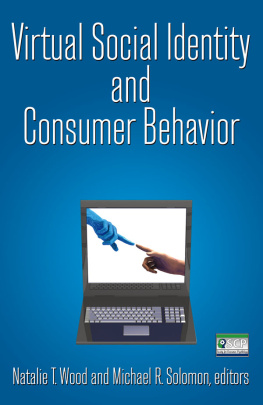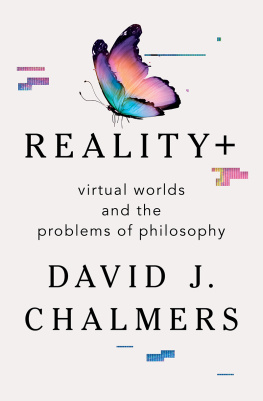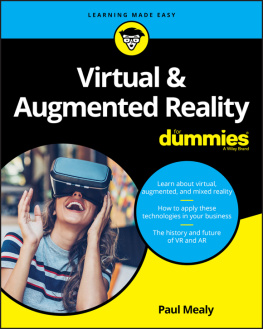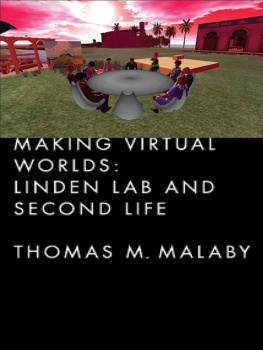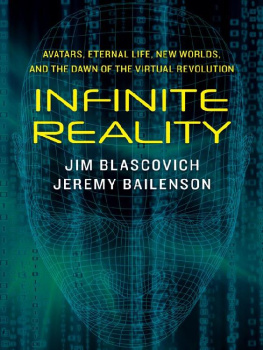Solomon Michael R. - Virtual Social Identity and Consumer Behavior
Here you can read online Solomon Michael R. - Virtual Social Identity and Consumer Behavior full text of the book (entire story) in english for free. Download pdf and epub, get meaning, cover and reviews about this ebook. City: London;New York, year: 2015, publisher: Taylor & Francis (CAM);Routledge, genre: Romance novel. Description of the work, (preface) as well as reviews are available. Best literature library LitArk.com created for fans of good reading and offers a wide selection of genres:
Romance novel
Science fiction
Adventure
Detective
Science
History
Home and family
Prose
Art
Politics
Computer
Non-fiction
Religion
Business
Children
Humor
Choose a favorite category and find really read worthwhile books. Enjoy immersion in the world of imagination, feel the emotions of the characters or learn something new for yourself, make an fascinating discovery.
- Book:Virtual Social Identity and Consumer Behavior
- Author:
- Publisher:Taylor & Francis (CAM);Routledge
- Genre:
- Year:2015
- City:London;New York
- Rating:5 / 5
- Favourites:Add to favourites
- Your mark:
- 100
- 1
- 2
- 3
- 4
- 5
Virtual Social Identity and Consumer Behavior: summary, description and annotation
We offer to read an annotation, description, summary or preface (depends on what the author of the book "Virtual Social Identity and Consumer Behavior" wrote himself). If you haven't found the necessary information about the book — write in the comments, we will try to find it.
Virtual Social Identity and Consumer Behavior — read online for free the complete book (whole text) full work
Below is the text of the book, divided by pages. System saving the place of the last page read, allows you to conveniently read the book "Virtual Social Identity and Consumer Behavior" online for free, without having to search again every time where you left off. Put a bookmark, and you can go to the page where you finished reading at any time.
Font size:
Interval:
Bookmark:
Virtual Social Identity
and
Consumer Behavior
First published 2009 by M.E. Sharpe
Published 2015 by Routledge
2 Park Square, Milton Park, Abingdon, Oxon OX14 4RN
711 Third Avenue, New York, NY 10017, USA
Routledge is an imprint of the Taylor & Francis Group, an informa business
Copyright 2009 Taylor & Francis. All rights reserved.
No part of this book may be reprinted or reproduced or utilised in any form or by any electronic, mechanical, or other means, now known or hereafter invented, including photocopying and recording, or in any information storage or retrieval system, without permission in writinfrom the publishers .
Notices
No responsibility is assumed by the publisher for any injury and/or damage to persons or property as a matter of products liability, negligence or otherwise, or from any use of operation of any methods, products, instructions or ideas contained in the material herein.
Practitioners and researchers must always rely on their own experience and knowledge in evaluating and using any information, methods, compounds, or experiments described herein. In using such information or methods they should be mindful of their own safety and the safety of others, including parties for whom they have a professional responsibility.
Product or corporate names may be trademarks or registered trademarks, and are used only for identification and explanation without intent to infringe.
Library of Congress Cataloging-in-Publication Data
Virtual social identity and consumer behavior / edited by Natalie T. Wood and
Michael R. Solomon.
p. cm.
Includes bibliographical references and index.
ISBN 978-0-7656-2395-9 (cloth : alk. paper)
I. Group identity. 2. Consumer behavior. 3. Virtual reality. I. Wood, Natalie T., 1970-II. Solomon, Michael R.
| HM753.V57 2009 | |
| 306.3dc22 | 2008053550 |
ISBN 13: 9780765623966 (pbk)
ISBN 13: 9780765623959 (hbk)
Contents
Michael R. Solomon and Natalie T. Wood
Robert V. Kozinets and Richard Kedzior
Leila El Kamel
Christian Hinsch and Peter H. Bloch
James E. Brown and Tracy L. Tuten
Kathy Keeling, Debbie Keeling, Antonella de Angeli, and Peter McGoldrick
David Crete, Anik St-Onge, Aurelie Merle, Nicolas Arsenault, and Jacques Nantel
Jeff Wang, Xin Zhao, and Gary J. Bamossy
J. Alison Bryant and Anna Akerman
Youjeong Kim and S. Shyam Sundar
Osei Appiah and Troy Elias
Yuliya Lutchyn, Brittany R.L. Duff, Ronald J. Faber, Soyoen Cho, and Jisu Huh
Melissa G. Bublitz, Craig C. Claybaugh, and Laura A. Peracchio
Introduction:
Virtual Social Identity
MICHAEL R. SOLOMON AND NATALIE T. WOOD
In his 1992 science fiction novel Snow Crash, the author Neal Stephenson first developed the construct of the Metaverse. This seminal book depicts a future where individuals inhabit two parallel realities; their everyday physical existence and their avatar existence in a 3D computer-mediated environment. The complicated marriage of everyday mundane life with a fantasy world in which an inhabitant assumes other identities opened the door to thoughts of digital social experimentationand presented a pathway to self-aggrandizement for those whose real world lives are less than ideal: the books protagonist is a humble pizza delivery boy in the real world, but a sword-wielding warrior in the Metaverse.
Since the release of Snow Crash almost twenty years ago, technology now allows Stephensons vision to become a reality. Over the last few years a flood of virtual worlds have come online. From Second Life to The World of Warcraft, There.com to MTVs Virtual Pimp My Ride, millions of consumers live a parallel life in a digital reality. A virtual world is an online representation of real-world people, products, and brands in a computer-mediated environment (CME). To many mainstream consumers and advertisers, this is largely an unknown or underground phenomenonbut it has real marketing consequences (Wood and Solomon, forthcoming). We are pleased to present selected papers in this volume from the first academic conference to specifically address these issues: the 2008 Advertising and Consumer Psychology Conference sponsored by the Society for Consumer Psychology (www.sju.edu/academics/centers/ccr/vsocialidentity.html) in Philadelphia.
Why the focus on this topic? In mid-2007, Charles River Ventures proclaimed that the virtual goods market was worth approximately $1.5 billion and growing rapidly. With more than 150 of these immersive 3D environments now live or currently in development, the number of consumers who come into contact with virtual goods as they navigate these worlds is projected to rise rapidly (150+ Youth-Oriented 2008). Indeed, according to one estimate, by the year 2012, 53 percent of kids and 80 percent of active Internet users will be members of at least one virtual world (Kids 2007; Virtual Greats Enters 2008).
Clearly, virtual environments will fuel new consumer trends over the next decade. McKinsey predicts that Virtual worlds such as Second Life will become an indispensable business tool and vital to the strategy of any company intent on reaching out to the video-game generation (Richards 2008). The Harvard Business Review predicts that within the next five years virtual environments are likely to emerge as the dominant Internet interface. In addition to corporate websites, companies will operate virtual stores where customers can browse and interact with assistants (Sarvary 2008). To date, numerous companies including IBM, GE, and Toyota have created CMEs for internal and external applications. Eventually, these CME forums may rival traditional marketer-sponsored e-commerce sites in terms of their influence on consumer decision making and product adoption.
However, due to the newness of the medium, advertisers still struggle to figure out the best way to talk to consumers in these environmentsor to decide if they should enter them at all. Ironically, this challenge is compounded by the unparalleled latitude both advertisers and consumers possess in these environments to assume virtually (pun intended) any physical form they wish. How will our understanding of source effects apply to advertising contexts where a company spokespersons avatar (or digital representation) is a fiery dragon, a sultry siren, or both at once? How does that company relate to a consumer whose avatar resembles George Bush, a furry creature, or a superhero? Welcome to the wild and woolly world of advertising in virtual worlds.
The last few years have been a bit of a Gold Rush for the brand-new virtual worlds industry as marketers eagerly competed to be the first in to stake a claim in a CME. Unfortunately many of these efforts failed to live up to expectations and we have been subjected to a slew of negative press. Virtual worlds are a fad, many naysayers claim. Gartner estimates that upward of 90 percent of virtual worlds that businesses launch will fail; most within the first 18 months. Yet, the same analysts also predict that 70 percent of organizations will establish their own private virtual worlds by 2012 (Cavall 2008). Despite such prominent failures as American Apparel and Starwood Hotels, there are many examples of success, including campaigns by Cosmo Girl and Toyota Scion in There.com and Nike in Second Life.
When executed properly, we firmly believe that virtual environments offer a higher level of immersion, interactivity, and engagement than many other web-based technologies. The promise is real, but its no longer sufficient just to plant a virtual stick in the ground. Advertisers need to think carefully about how to calibrate their strategic objectives with the unique characteristics of these environments.
Next pageFont size:
Interval:
Bookmark:
Similar books «Virtual Social Identity and Consumer Behavior»
Look at similar books to Virtual Social Identity and Consumer Behavior. We have selected literature similar in name and meaning in the hope of providing readers with more options to find new, interesting, not yet read works.
Discussion, reviews of the book Virtual Social Identity and Consumer Behavior and just readers' own opinions. Leave your comments, write what you think about the work, its meaning or the main characters. Specify what exactly you liked and what you didn't like, and why you think so.

